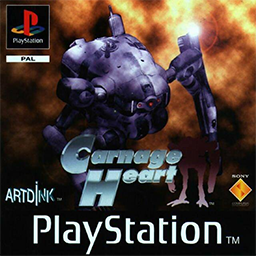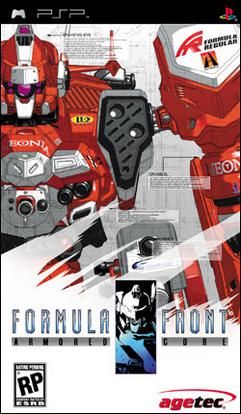
Soul Edge is a 1996 fighting game developed and published by Namco for arcades. It is the first installment in the Soulcalibur series. Introduced at the JAMMA trade show in November 1995, the full arcade game was released in February 1996 on System 11 hardware, the same board used by Tekken and Tekken 2. Later in December an upgraded and expanded version of the game was ported to the PlayStation; this version was renamed to Soul Blade outside Japan and released in 1997.
Armored Core is a third-person shooter mecha video game series developed by FromSoftware. The series centers on a silent protagonist who takes on work as a mercenary pilot in the far future, operating large robot combat units known as Armored Cores at the behest of corporate and private clients. As the player completes missions for these clients, they gain credits to improve their Armored Core and unlock further opportunities to make money. Some games include an "Arena" mode in which the player fights other Armored Core pilots in head-to-head battles, which can reward the player with further income or prestige.

Carnage Heart is a turn-based tactics video game developed by Artdink for the PlayStation. Sony Computer Entertainment released the game outside Japan in 1997.

Armored Core is a 1997 third-person shooter mecha video game developed by FromSoftware for the PlayStation. The first installment in the Armored Core series, it was released outside Japan by Sony Computer Entertainment. A digital port was released in 2007 in Japan and 2015 in North America on the PlayStation Network as a part of the PSone Classics line of games.

Armored Core: Master of Arena is a 1999 third-person shooter mecha video game developed and published by FromSoftware for the PlayStation. Master of Arena is the third entry in the Armored Core series and a direct sequel to Armored Core: Project Phantasma. It is the final game in the original Armored Core trilogy. The game was not released in Europe. An indirect sequel, Armored Core 2, was released on August 3, 2000, for the PlayStation 2.

Armored Core 2 is a 2000 third-person shooter mecha video game developed by FromSoftware for the PlayStation 2. It is the fourth entry in the Armored Core series and an indirect sequel to Armored Core: Master of Arena. In North America, Armored Core 2 was a launch title for the PlayStation 2. A direct sequel, Armored Core 2: Another Age, was released in 2001 for the PlayStation 2.

Armored Core 2: Another Age is a 2001 third-person shooter mecha video game developed by FromSoftware for the PlayStation 2. It is the fifth entry in the Armored Core series and a direct sequel to Armored Core 2. A reboot of the series, Armored Core 3, was released in 2002 for the PlayStation 2.

Armored Core 3 is a 2002 third-person shooter mecha video game developed by FromSoftware for the PlayStation 2. It is the sixth entry in the Armored Core series. Armored Core 3 acts as a reboot for the franchise and begins a storyline that would continue through Armored Core: Last Raven. In 2009, Armored Core 3 was ported to the PlayStation Portable.

Silent Line: Armored Core, known in Japan as Armored Core 3: Silent Line, is a 2003 third-person shooter mecha video game developed by FromSoftware for the PlayStation 2. It is the seventh entry in the Armored Core series and a direct sequel to 2002's Armored Core 3. In 2009, Silent Line: Armored Core was ported to the PlayStation Portable.

Armored Core: Nexus is a 2004 third-person shooter mecha video game developed by FromSoftware for the PlayStation 2. It is the eighth entry in the Armored Core series and a sequel to 2003's Silent Line: Armored Core. Unlike Silent Line, Nexus is not an expansion but rather a full-fledged sequel.

Armored Core: Nine Breaker is a 2004 third-person shooter mecha video game developed by FromSoftware for the PlayStation 2. It is the ninth entry in the Armored Core series and a spin-off to Armored Core: Nexus.

Armored Core: Last Raven is a 2005 mecha-based vehicular combat game developed by FromSoftware. It is part of the Armored Core series and is a direct sequel to Armored Core: Nexus (2004). The game was originally released for the PlayStation 2 and was ported to the PlayStation Portable in 2010. Gameplay remains largely unchanged from the game's predecessors and is centered around piloting a large mech in combat missions for various clients. The game is also notable for being the debut project of future FromSoftware president Hidetaka Miyazaki.

Armored Core: Formula Front is a mecha video game developed by FromSoftware and published by Agetec. It was a launch title for the PlayStation Portable in Japan, the 10th main installment in the Armored Core series.

Armored Core 4 is a 2006 mecha-based vehicular combat game developed by FromSoftware for the PlayStation 3 and Xbox 360. The fourth main entry of the Armored Core series, the game serves as a reboot for the franchise and is set in the future where a war has made the nations of Earth devastated and their respective governments have been replaced by corporations. Conflicts soon begin to break out between the corporations, which use massive combat robots, Armored Cores, to fight each other. The player is a Lynx, a name given to pilots of highly advanced NEXT Armored Cores.

Armorines: Project S.W.A.R.M., known as Armorines in Europe, is a 1999 first-person shooter developed by Acclaim Studios London and released for the Nintendo 64, Game Boy Color and PlayStation. It is based on the Armorines comic book from Valiant Comics, which was bought by Acclaim Entertainment.

Armored Core: For Answer is a 2008 mecha-based vehicular combat game developed by FromSoftware and published by Ubisoft for the PlayStation 3 and Xbox 360. It is the 13th installment in the mecha-based Armored Core series, the game is the direct sequel to Armored Core 4.

The PlayStation Link Cable (SCPH-1040) is a peripheral cable for the first generation PlayStation console. Utilizing the serial I/O port found on the back of most PlayStation models, it allows for two consoles to be connected in order to play compatible multiplayer games on separate consoles and displays. The cable is a 8-pin inline serial cable and was a fully supported Sony accessory for the market life of the console. It is not compatible with the redesigned PS one or newer PlayStations.

Armored Core V is a mecha-based video game developed by FromSoftware and published by Namco Bandai Games for PlayStation 3 and Xbox 360. It is the 14th main installment in the Armored Core series and a return to the more traditional style of gameplay found in the original series of games.

Armored Core: Verdict Day is a mech action game developed by FromSoftware and was published worldwide in September 2013 by Namco Bandai Games for PlayStation 3 and Xbox 360. It is the 15th installment in the Armored Core series and a direct sequel to Armored Core V.

Auto Destruct is a video game developed by the Swedish studio Neurostone and published by Electronic Arts. It was released for the PlayStation. The player takes on the role of a retired race car driver hunting down the fanatical cult that murdered his wife and daughter. The music was composed by English electronic producer Danny Briottet.


















